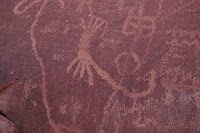At
Valley of Fire State Park, Nevada's oldest and one of the loveliest, I've done the White Domes walk several times. It's beautiful, with its deep natural stairs, slot canyon, and pale fine sand underfoot. This time, though, I wanted to see petroglyphs. There are so many petroglyph sites within reach of Vegas that it seemed a shame that the most memorable ones I've seen are at Newspaper Rock 'way over in eastern Utah.
So we stopped at Atlatl Rock, named for the dart throwing tool that appears in the petroglyphs. There's a steel walkway up to the viewing platform, built into the rock beside the petroglyphs. It's amazing to me that people made these representational works about 4000 years ago, and we can still clearly recognise some of the shapes.
This makes me realise how similar our minds are - somehow daily life seems to emphasise the differences rather than the similarities. I was especially taken with the sheep and the scorpion, and this panel that looks like it tells a story but to be honest I am too lazy to try and parse it.
 |
| scorpion, I presume |
|
 |
| panel of petroglyphs |
|
 |
| bighorn sheep |
|
 |
4k years ago, people were here shooting bighorn sheep
... or at least making artworks on the subject.
At left, nearly covered by varnish. |
Away from the walkway, there was almost nobody around, although the carpark was more than half full and several barbecue picnics were in progress. We wandered around nearby rocks and saw even more petroglyphs, including one just a few feet off the ground that looks like it's nearly covered with desert varnish, and whole flocks of sheep.
Afterwards, we went to the visitor centre, where they have, among many other things, a live scorpion glowing in uv light (intelligent design? Cos why would you make glow-in-the-dark scorpions? I'm just sayin') Also a stuffed bighorn sheep, presumably shot in some earlier iteration of park management style.
Then up to the Rainbow Vista trailhead. I still haven't seen the eponymous vista but we did hike to the Fire Canyon overlook, where the richness of colour in the late afternoon light was matched only by the intricate contours within the rocks.
 |
| human tracks everywhere |
Wherever people have walked, the sand is loose and blowy, comes up over your shoes, and is a workout to walk in. But where people have not walked, the sand forms a light crust that resists the persistent promptings of the wind. It should not be disturbed, as it's fragile, taking decades to recover from a single human footprint.
And this
cryptobiotic crust, most amazingly, holds the finest of animal tracks. (Even more amazingly, the camera did my bidding and I was able to bring some back to share with the whole class.)
Here I found my second scorpion trace of the day - if you count the petroglyph as the first. We saw any number of lizard tracks, and what look like kit fox prints (thanks
naturetracking.com for helping me figure these out! Kit fox prints are like other fox prints in their shape and pattern, but kit foxes have furry pads to protect them from the heat, so you don't see the claw marks very well.) There were a few fence lizards and ground squirrels skittering around - Simon saw a lizard actually making tracks, but too fast to photograph.
 |
| fox and human tracks |
|
 |
| all the invertebrates. Scorpion tracks towards RHS |
|
 |
| fence lizard tracks |
|
 |
Just the other day, people were here shooting bighorn sheep
... centre, just below the ridgeline |
I didn't photograph any bighorn tracks either, though I saw a couple and plenty of scat. Then just as we were driving the narrow and spectacular road back down to the highway, a grey shape caught my eye: a bighorn sheep was standing on a high promontory above the road. Got it, too - though not so very well, what with haste, backlight, and being too busy in the wonder of the moment immediately to reach for a camera.
It showed neither fear nor interest as we watched it turn towards the west and settle onto the rocky ledge. (It probably gets shot all the time.) Then we turned our faces likewise towards the setting sun and home.














No comments :
Post a Comment
Note: Only a member of this blog may post a comment.